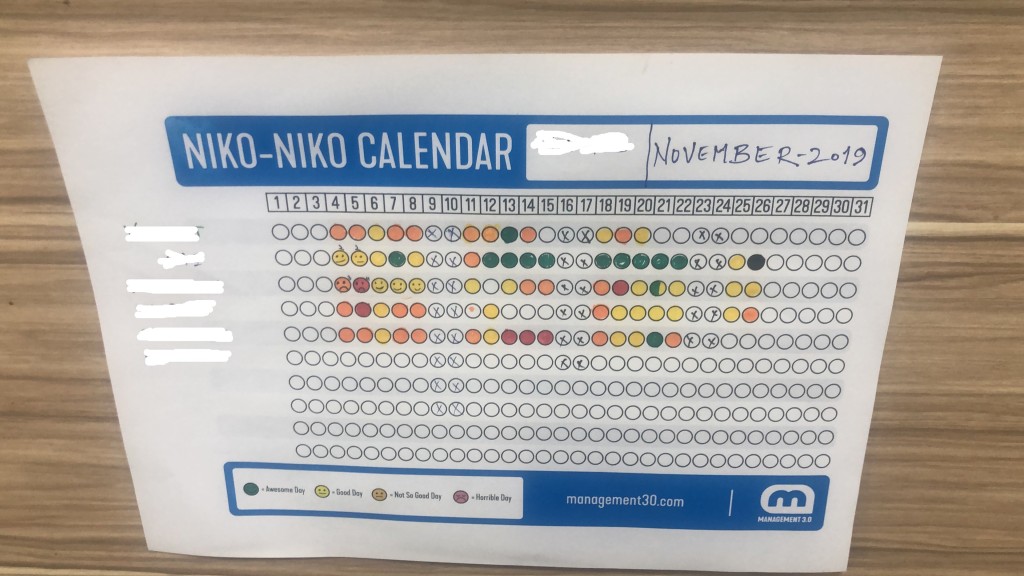When I saw Niko-Niko recently in the management 3.0 practices, it reminded me of the emotional seismograph I do during release retrospective. I will explain more on the emotional seismograph later, but the Niko-Niko looked like an amazing way to constantly capture the mood of the people.
The practice is very simple where a person while leaving office tells the mood he/she is leaving with. Either the whole teams do it together describing the mood in few words if possible, or worse case you just mark it in the public visible calendar. Some people use colors, others just update the box with smiley. This time I gave them the choice to choose colors.
The intent is very clear; we want to know the emotional sentiment of the team as they work. Scrum Teams work as a team which rallies around work or in a typical sprint around the goal, and a team having team members unhappy some days in a row is alarming. While I often tell managers not to challenge people on why they are happy, I tell them to look at trends or the patterns.

While introducing the technique 1 challenge I faced was some people telling to remove the names. I’ve removed the names in the image for Confidentiality, but if you see on the left names are written for each person inside the scrum team (I do it scrum team wise, but actually can be done at any level). The thing I explain people is that if I feel that people telling how their day went can’t be public, there is another issue which needs to be solved. It means people are not safe. Safety is a bigger issue to address. If my teams are not safe to reveal this, I’ll have that issue resolved first, because psychological safety is priority for me. So I’m always able to convince people that let there be names, because people feel safe, and if they are not, then that team needs attention from a different perspective.
One day before sprint end, probably everyone is busy, and expecting a good day is tough, and same way the second day of the sprint is probably good for everyone. Again, these observations might be wrong generalizations and I believe data should speak for itself. Again, this data is so unique with each team, and with everyone. You don’t get to hear a story or a reason, but then the objective data is enough to identify if the team is in stress, or if an employee is feeling too bad.
The patterns are often useful in 1-1 conversations or even tea conversations. I’ve even seen team mates talk to each other, what happened dude, you are having bad days every day. And it’s good because as human beings it’s good that we try to be happy, but it also makes sense for us to show empathy if someone else is not.
I take the monthly data and try to get patterns and share that with leadership. A Team recently was stretching a lot, and I could see constant full team bad moods, and while talking to some folks, I could easily figure it out. I gave the feedback to them to slow down. Again, the idea is to get inference and do something on inference. It should have some intent and purpose attached.

Often a blank sheet gives more noise.
In same way the emotional seismograph Is what I do at every release retrospective, where I make a line graph, plotting a sad and happy smiley on y axis, and then on x axis either keeping sprints or months (depending on size of release). I start the release retrospective using this, where I tell people to draw points and hence connect points to get a line showing how their release went from a team perspective. It solves multiple purpose, firstly I tell them that while you are drawing your line, think about all the sprints, kind of self-reflect because it is a release retro and they need to think about the entire release. It also shows the emotional quotient of the team. If you see in middle of the release the line going to sad for majority, something happened. If the ending of the release was ending for everyone at a low, something bad happened in the end. And intent is for people to get these points in their mind for the next activities. Again, I’ve done this at least 40 times, and every time it teaches me things.

The Human sentiments is a powerful thing not because humans are sensitive, but because the sensitivity drives the passion, the behaviors and they tell how we will work. A happy employee is what everyone wants, but we need to know if they are unhappy and act accordingly.
Happiness is a big thing.
If you want to learn more about Niko-Niko calendar, you can look at the management 3.0 page here on the same.

